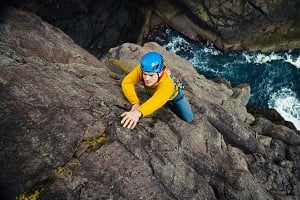

Many hill folk hold the view that there is no such thing as winter hillwalking in Scotland and that all trips to Scottish hills during the winter months are no less than winter mountaineering. The point is well made and most people would agree that battling with blizzard conditions in the Cairngorms or traversing an ice clad ridge in the Mamores requires the full range of winter equipment and skills. But there are also those days when winter conditions are not present and to simply describe every adventure which is undertaken between October and May as 'mountaineering' is at best confusing and at worst may turn people away from making sound decisions when winter conditions do prevail. The devil, as they say, lies in the detail.
One of the difficulties is that a stretch of ground which is relatively straightforward to negotiate one week might present a challenge the next week, requiring all the skills of navigation, ice axe and crampon use and avalanche awareness. Conditions in the UK have always been changeable and in recent years there have been bizarre fluctuations where massive snowfalls have created huge accumulations of snow only to disappear in a few days and then be replaced all over again shortly after. An overnight drop in temperature can change relatively easy grassy slopes into icy deathtraps where all the water has been frozen solid. This hazard is made worse because the slopes may still look green and the ice can't be seen until you actually set foot on it.
So what's the problem with the term 'winter hillwalking'? Perhaps there is a perception that hillwalking is less serious than mountaineering and that by identifying with a less serious activity the risks will be less serious. What we mean by the word "winter" is critical. Winter mountaineering conjures up pictures of ice axes, crampons, challenging navigation and hazardous slopes. To some people winter hillwalking might imply terrain which is gentler, lower and generally less serious. To others it might mean many of the Munros which have presented no problems in summer and which will be OK during the winter as long as the intention is only to go hillwalking on them and not mountaineering. This is the flaw.
"...Winter mountaineering conjures up pictures of ice axes, crampons, challenging navigation and hazardous slopes..."
There may be times when people consider they are only hillwalking when in reality they are mountaineering. The important distinction is whether the conditions at the time require winter equipment and skills. As a general rule these are needed when there is snow or ice or if the temperature is sub-zero (or has recently been sub-zero). If we can be sure that there won't be any ice and that any snow will be soft, with no underlying hard layer, and that we won't be on any slopes of sufficient angle for a slip to become a fall or an uncontrollable slide, then perhaps we won't need all the winter gear. This is a big 'if' and there isn't much room for error.
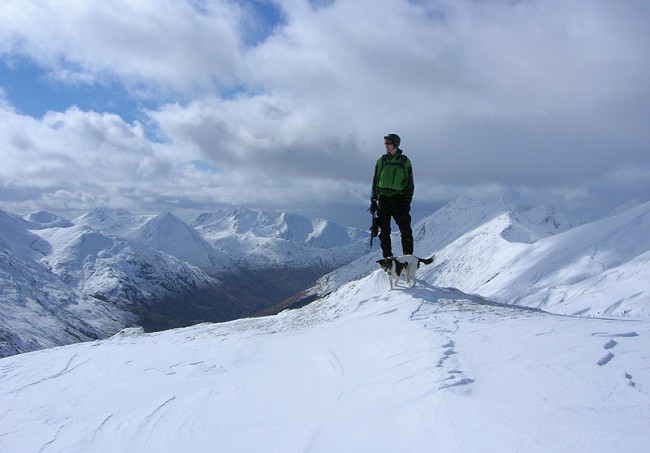
Deciding not to take axe and crampons, on the basis of a judgement about what conditions are likely to be, is sailing close to the wind and if we make a habit of this we are likely to be caught out. Even if our judgement is correct about the conditions on the intended route there is still the possibility we might end up on more serious terrain because of a navigation error or because the weather dictates a change of route. Also, the idea that we don't need all the gear because we will always be able to turn back if conditions become too much is a myth. Turning back is, of course, an important safety option but to use it as a means of justifying going ill-equipped is nonsense. It's easy to take a chance but it's far better to be aware of the risks and to be ahead of the game.
Another myth is that axe and crampons are only needed for steep icy ground on craggy mountains. People have been injured by slipping on relatively easy angled slopes. Although winters have possibly become even more fickle in recent years, when winter conditions do arrive they can be just as challenging and the skills and equipment are just as important as ever. Slopes of any angle which are covered in snow or ice, or are just frozen, can present a lethal hazard which requires axe and crampons to negotiate safely. A recent study by Bob Sharp, a former chair of the Mountain Rescue Committee of Scotland, claims that 27% of all incidents involve slips, trips and stumbles and goes on to conclude that slips often have dire consequences, particularly in winter when a slip can result in a very long fall. The research can be viewed and downloaded from here.
"...So where an incident happens to a hillwalker in winter,
there is an increased chance that it will be serious..."
Is there any difference between a slip and a fall? Mountain incident records certainly differentiate between the two. In a "slip" the casualty does not change location. In contrast, people who have a "fall" have moved a considerable distance, often with severe injury. Falls often occur as a result of a slip. Overall, across all the seasons of the year, 20% of all slips to walkers result in a fall. Of all the slips that result in a fall, some 37% take place over the four-month period from December to March. This is more than the third which would be a proportionate number for four months of the year and, when we consider that more people probably go to the hills in summer, we can conclude that if a hill walker slips in winter there is a higher chance that he or she will fall a considerable distance than if they had slipped at any other time of the year (winter conditions can occur long before December and well beyond March).
The study also examines the overall pattern of injuries to hill walkers. There are more fatal injuries and more multiple injuries in winter. So where an incident happens to a hillwalker in winter, there is an increased chance that it will be a serious one. To sum up, winter hill walking in Scotland, in proper winter conditions, is no less than mountaineering.
Develop the skills, take the right gear and have a great time.
- Click here for the latest Mountain Weather Forecasts.
- Click here for the latest information from the Sportscotland Avalanche Information Service.
Winter Skills and Gear
Navigating in poor winter visibility
Recent studies tell us that errors in navigation account for 23% of mountain rescue incidents and so this is clearly a crucial skill. It's essential to have a map in a waterproof cover and a decent compass. Equally important are the skills required to navigate effectively in poor visibility and challenging conditions. There are very few navigation techniques which only apply to winter but the conditions in which they have to be executed can be far more challenging than they are in summer. Winter navigators need to be well practiced in contour interpretation, estimating distance, using compass bearings and selecting a practical route. There are many sources of information about navigation - for a quick hit check out the Navigator's Dozen on the Mountaineering Council of Scotland's website.
Avalanche
You might think that we don't get the winters we used to, but the huge fluctuations of snowfall in recent years have created situations where we can have a high avalanche hazard followed by a huge thaw which eventually creates a stable snowpack only to be reproduced all over again in the following week. Check the sportscotland Avalanche Information Service outlook and consider doing a course to improve your knowledge. The MCofS runs one-day courses held in January.
Ice Axe
Secure footwork is the cornerstone of safe mountain travel, in both summer and winter. The primary purpose of the ice axe is to provide balance and support which enables secure footwork and prevents slips. A secondary use is for self-arrest or ice axe braking in the event that a slip has occurred. All of these techniques are crucial skills which are not only needed on steep mountainsides; relatively easy angled slopes are also the scene of many incidents. A couple of days training can be a lifesaving investment. Have a look at the MCofS winter skills courses in January. If you're not already a member, joining costs less than the discount you get on the course, so it's a double investment.
Boots
Boots need to be relatively stiffsoled with sufficient rigidity to create secure footsteps by using the side edges or toes. They don't need to be heavy or fully stiffened mountaineering boots but if you can bend the sole easily in your hands then it's too soft and bendy to create secure footsteps. Rounded heels are no good because you can't create a firm step when descending. Don't be fooled into thinking that stiff soled boots are only needed on steep slopes. Many slips and falls occur on relatively easy angled slopes on popular hillwalking routes.
Crampons
Crampons complete the secure footing package and using them effectively is a skill which takes time to develop. A common mistake is trying to use the uphill edge in the same way as we use our boot edges when not wearing crampons. Another error is only engaging the heel when descending rather than getting all the points into contact with the snow or ice. Even half a day of training with someone who can demonstrate the correct technique will make a huge difference. A wide variety of crampons and methods of attachment is available and it is possible to fit a crampon to almost any boot. However, crampons are not as effective with bendy boots and we still need relatively stiff soles for secure footwork when not wearing crampons. A secure fit between boot and crampon is essential. Some crampons will only fit certain types of boots.
This article was first published by the Mountaineering Council of Scotland.
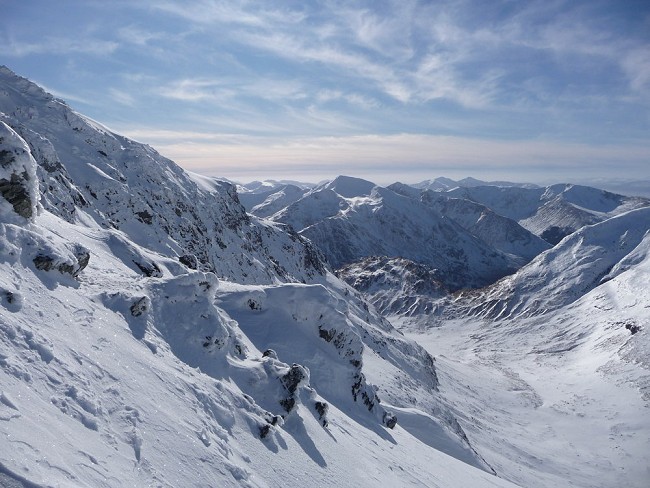
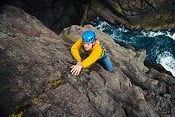
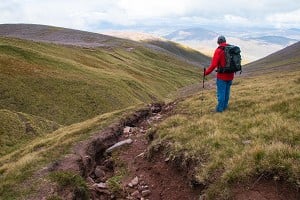
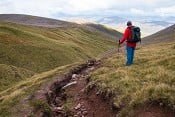
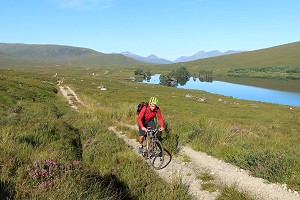
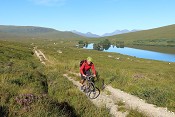
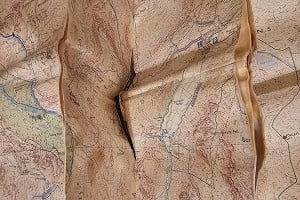
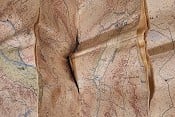




Comments